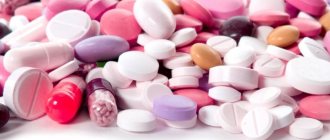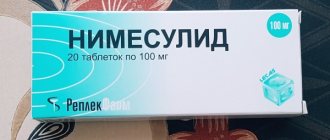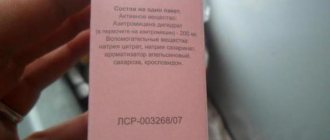ACC (Acetylcysteine) is a drug with an expectorant and mucolytic effect, which is prescribed to liquefy viscous bronchial secretions in diseases of the respiratory system that occur with the formation of thick, difficult-to-clear sputum.
The history of the invention of the drug occurred in the middle of the last century. It was then that Professor Ferrari, who worked in an Italian pharmaceutical company, discovered the similarity of acetylcysteine with the protein cysteine, which has the ability to break apart the mucopolysaccharide molecules that make up bronchopulmonary secretions. The first drug based on acetylcysteine was called Fluimucil.
Pharmaceutical group: Mucolytic drug.
pharmachologic effect
The mucolytic effect of the drug is provided by the active substance acetylcysteine, which is a derivative of cysteine (amino acid). The acetylcysteine molecule has sulfhydryl groups in its structure, which contributes to the disruption of disulfide bonds of mucopolysaccharides in the composition of sputum, which ensure the viscosity of the secretion. As a result, the sputum softens and is more easily separated from the walls of the bronchi.
The drug has a direct effect on the thickness and rheological properties of sputum, maintaining proper activity even with purulent impurities in the bronchial secretion. With the prophylactic use of acetylcysteine, patients with cystic fibrosis and chronic bronchitis note a decrease in the number and severity of exacerbations.
Another effect of acetylcysteine is an antioxidant pneumoprotective effect, which is realized by binding and neutralizing chemical radicals with sulfhydryl groups. The drug accelerates the synthesis of glutathione, a factor of intracellular protection from a number of cytotoxic substances and oxidative toxins of internal and external origin, which allows the use of ACC in case of paracetamol overdose.
Pharmacokinetics
It is quickly and completely absorbed, undergoing metabolism in the liver. During metabolic reactions, pharmacologically active cysteine and a number of other mixed disulfides are formed. Bioavailability is only about 10%. The maximum concentration is achieved in the blood 1-3 hours after administration. The connection with flame proteins reaches 50%. Acetylcysteine is excreted by the kidneys as inactive metabolites. The very rapid half-life of about 1 hour is explained by the biotransformation of the substance in the liver. With liver dysfunction, this period increases to 8 hours.
Analogs
The following drugs are analogues of ACC:
- For active ingredients: Acestine, Acetylcysteine, Vicks Active ExpectoMed, Mukonex, Fluimucil, N-AC-ratiopharm;
- By mechanism of action: Ambrobene, AmbroHexal, Ambroxol, Ascoril, Bromhexine, Bronchobos, Bronchoxol, Bronchorus, Bronchosan, Bronchostop, Bronchotil, Joset, Cashnol, Lazolvan, Libexin Muco, Medox, Neo-Bronchol, Pulmozim, Remebrox, Sinupret, Solvin, Flavamed , Fluifort, Fluditek, Halixol, Erdomed, etc.
Contraindications to taking ACC
- Exacerbation of peptic ulcer and duodenum;
- Pulmonary hemorrhage, hemoptysis;
- Pregnancy and lactation, ACC is prohibited during pregnancy at any stage;
- Individual intolerance;
The instructions for use of ACC for children indicate that treatment is possible strictly according to medical prescription; the following is contraindicated:
- Children under 2 years of age (except for granules for preparing the drug in a bottle and injections).
- Children under 6 years of age (200 mg granules);
- Children under 14 years of age (600 mg granules).
It is prescribed with caution to people with pathological dilation of the veins in the esophagus, at risk of bleeding from the lungs, bronchial asthma, pathology of the adrenal glands, insufficiency of liver and kidney function.
Composition and dosage forms
ACC is the abbreviated name for the active substance of the drug - acetylcysteine, a cysteine derivative. The compound has a pronounced mucolytic effect: it increases the volume of mucous secretion, dilutes it, and helps its natural discharge from the respiratory tract.
The drug is produced in several forms for oral use. This is very convenient when selecting treatment regimens for patients of different ages.
- Effervescent pills in dosages from 100 to 600 mg: white, with a light berry aroma. Auxiliary and formative components: soda, citric acid, lactose and others.
- Granular mixtures with a concentration of 100–200 mg of the active component for hot solutions.
- Children's powder in bottles of 30 and 60 g for the preparation of medicinal drinks. Smells like citrus or honey. The composition also contains sugar, flavorings, and vitamin C.
Dosage
Effervescent tablets ACC 100 and 200 mg
The tablet should be dissolved in water (100 ml) and taken immediately after preparation. In exceptional cases, it is permissible to store the solution for a maximum of 2 hours. Take after meals, with additional water.
- Children 2-5 years : One tablet 100 mg or half a tablet 200 mg three times or twice a day (200-300 mg per day).
- Children 6-14 years old: One 100 mg tablet or half a 200 mg tablet three times a day. 2nd regimen: two tablets of 100 mg or one tablet of 200 mg twice a day (300-400 mg per day).
- Adolescents from 14 years old and adults: one tablet 200 mg twice or thrice a day (400-600 mg per day).
In cases of cystic fibrosis, the dose and regimen are different.
- Children 2-6 liters: one 100 mg tablet or half a 200 mg tablet four times a day (200 mg per day).
- Children over 6 years of age: two tablets of 100 mg or one tablet of 200 mg three times a day (600 mg per day).
For patients weighing more than 30 kg, a daily dose of 800 mg is prescribed, evenly distributed over doses.
Granules
The instructions for use of ACC powder indicate the method of preparing the dosage form. Half a sachet or a sachet is dissolved in juice, chilled tea or water and the composition is drunk after meals. To obtain syrup, add drinking water to the bottle up to the mark and shake.
- Children under 2 liters: 50 mg (half a scoop) two or three times a day (100-150 mg per day). Strictly as prescribed by the doctor!
- Children 2-5 liters: One measuring spoon (100 mg) 2-3 times a day (200-300 mg per day).
- Children 6-14 liters: One scoop (100 mg) three times a day (300-400 mg per day).
- Adolescents over 14 years of age and adults: Two scoops (200 mg) two to three times daily (400-600 mg per day).
The dosage regimen for cystic fibrosis is similar to tablets.
Syrup
- The syrup is taken after meals, measuring out the proper amount with a syringe or glass. 10 ml of syrup = half a glass or 2 full syringes. It should be taken with water to increase the mucolytic effect.
- Children 2-5 years old: 5 ml of syrup 2-3 times a day (200-300 mg per day);
- Children 6-14 years old: 5 ml of syrup 3 times a day or 10 ml twice a day (300-400 mg per day);
- Children over 14 years old, adults: 10 ml of syrup 2-3 times a day (400-600 mg per day).
For cystic fibrosis:
- Children 2-6 years old: 5 ml of syrup 4 times a day (400 mg per day);
- Children over 6 years old: 10 ml of syrup 3 times a day (600 mg per day).
Injection
Intended for intravenous or intramuscular administration only in a hospital setting.
- IM: injected deep into the muscle. IV: diluted with 0.9% NaCl in a 1:1 ratio, slow administration.
- Children 1-6 liters: 10 mg of solution per 1 kg of body weight.
- Children 6-14 years old: 150 mg (one and a half ml) 1 or 2 times per day.
- Children over 14 years old and adults: 300 mg (3 ml) 1-2 times a day.
Duration of reception. Short-term colds: 5-7 days. More severe illnesses – for a long time, as prescribed by a doctor.
Drug interactions ACC
Tetracycline antibiotics (with the exception of doxycycline) are not recommended for use simultaneously with ACC Children. Cases of inactivation of antibiotics of other groups by acetylcysteine were noted exclusively during in vitro , with direct mixing of the latter. But for the safety of the patient, the interval between taking antibiotics and acetylcysteine should be at least 2 hours. When using the drug simultaneously with antitussives, due to a decrease in the cough reflex, dangerous stagnation of mucus is possible. Acetylcysteine may potentiate the vasodilating effect of nitroglycerin. In vitro, acetylcysteine is incompatible with semisynthetic penicillins, cephalosporins, and aminoglycosides. There is no data on the incompatibility of the drug with antibiotics such as amoxicillin, erythromycin and cefuroxime.
special instructions
- The drug should be diluted only in glass containers. Upon contact with metals, sulfides are formed.
- Patients with asthma and obstructive bronchitis should monitor bronchial patency.
- If any side effects develop, stop taking the drug.
- Patients with diabetes mellitus should take into account the glucose content: in 100 mg of ACC - 0.006 XE.
- Does not affect the ability to drive a car or operate complex machinery.
- Prescribe with caution for kidney and liver pathologies.
Indications
The drug is prescribed for the symptomatic treatment of respiratory and hearing diseases:
- pathological processes of the bronchi and lungs, leading to excessive production of mucous secretions;
- cough due to ARVI, tracheitis, laryngotracheitis;
- acute, chronic, obstructive bronchitis;
- cystic fibrosis;
- acute and chronic pneumonia;
- lung abscesses;
- otitis media of the middle ear with stagnation of exudate;
- sinusitis.
For which cough is it better to take ACC?
The medication is recommended mainly for wet coughs to facilitate breathing and accelerate the removal of mucus from the bronchi (lungs). But, judging by patient reviews, ACC is also effective for dry cough. Helps to move into the wet active phase.
The benefits of ACC will be greater if taken according to indications, since, for example, the drug is unlikely to be effective in relieving cough spasms. The action of the active components of the drug is aimed at combating mucus if it accumulates directly in the respiratory cavity. Sputum begins to settle on the walls of the bronchi. Due to excessive density (viscosity), it can no longer move out naturally, which provokes the appearance of paroxysmal coughing.
ACC helps to enhance the process of movement of mucus to the outside, and thanks to the amino acid (cysteine) in the composition, it influences the consistency and structure of accumulated mucus, transforming it into a more diluted state. The drug causes mucus to come off from the walls of the bronchi and begins to push out accumulations from the respiratory tract, thereby healing the mucous membrane and helping to restore its protective reactions.
ACC, as a medicine, perfectly dilutes purulent accumulations, therefore it is recommended to be taken together with antibacterial agents for complex therapy. Acetylcysteine in the composition is an excellent antioxidant, therefore it not only actively affects sputum, but also suppresses the invasion of viral infection (regardless of the etiology).
The medicinal ACC perfectly eliminates cough spasms and flu symptoms. It is recommended that children be given a well-digested, sweet-tasting syrup. The drug helps with both wet and dry – non-productive cough. The main thing is to follow the dosage and frequency of taking the medication, drink more fluid for better coughing up of mucus and increased effectiveness. If complex cough treatment is carried out, it is recommended to maintain an interval between doses of other medications with a duration of 2 - 2.5 hours.
The effectiveness of acetylcysteine
Acetylcysteine is the active component of the mucolytic ACC. Its task is to liquefy sputum, further removing it from the respiratory systems, preventing various respiratory inflammations.
According to the instructions, ACC can be given to children aged three years for the following indications:
- bronchitis of various types;
- tracheitis;
- pneumonia;
- purulent otitis;
- laryngitis;
- sinusitis.
Doctors can prescribe ACC for all diseases that are accompanied by excessive accumulation of mucus in the bronchi.
Duration of taking the medicine
Before taking any medication, the patient must study all possible contraindications and adverse reactions. Knowing such information will help determine whether such a drug can be taken at all in a particular situation. The main contraindications of ACC-200 include:
- the beginning of ulcer progression;
- the presence of bleeding in the lungs or the release of blood along with sputum;
- in the presence of any type of glucose-galactose deficiency;
- women carrying a child and breastfeeding;
- children who have not yet turned 6 years old.
In addition, patients who have an increased allergic reaction to the additional components in the composition or to the main active substance are prohibited from using the drug.
Patients should be especially careful when taking “ACC” in powder form:
- hypertension;
- bronchial asthma (in acute conditions it is completely prohibited);
- peptic ulcers;
- diseases of the adrenal glands;
- allergy to histamine;
- renal or liver failure.
It is also important to remember that the use of medications, especially long-term use, can at any time provoke the appearance of a negative reaction - allergies, breathing problems, dyspeptic disorders, and more. Most often, conditions of this type occur as a result of an overdose.
Price of ACC for cough
The form of release not only contributed to the freedom of choice of the buyer, but also significantly influenced how much ACC costs in pharmacies. More often, its price is very reasonable, which makes the medicine accessible to every social class of the population. However, in different cities and pharmacies, prices for medicine may vary slightly. The average cost of the drug is:
- baby syrup – price up to 350 rubles;
- granular ACC - up to 200 rubles;
- powder – 130-250 rubles;
- orange and honey flavored powder – price from 250 rub.
What does the powder contain?
"ACC-200" is a powder of small granular particles. One sachet contains 200 mg of active drug. The drug contains the following components:
- acetylsteine;
- additional substances - honey, citrus flavors, sucrose, saccharin, as well as ascorbic acid.
Small granules in powder are painted white, less often yellow. If you sniff, you can smell citrus and honey.
Instructions for use
In pharmacies, ACC is available to children aged 3 years without a prescription, as it is safe and non-toxic. However, a doctor must prescribe treatment with the drug.
Children's ACC can be taken by children no earlier than two years old. The dosage of ACC for a 3-year-old child is 100 mg , since it contains a minimal amount of acetylcysteine. A medicine with a dosage of 200 mg and an injection solution are most often used to treat colds in children over 6 years of age. Doctors prescribe acetylcysteine with prolonged effect (ACC Long) to young patients over 14 years of age, since this medicine contains the highest dose of the active component.
The treatment regimen and course are determined by a pediatrician depending on the child’s age, the nature of the disease and his individual characteristics.
Information for parents
Before using ACC for a 3-year-old child, parents must exclude all contraindications.
The drug should not be given in the following cases:
- ulcers;
- sensitivity to lactose or acetylcysteine;
- bleeding caused by the disease.
There are a number of pathologies that require consultation with a doctor before treatment. Such diseases include adrenal and kidney dysfunction, asthma, high blood pressure, and liver diseases.
Due to its safety, it is allowed to give ACC to a three-year-old child. For young patients, the medicine was given a pleasant berry and fruit taste. Side effects are rare, but the main reason for the development of adverse reactions is violation of the rules for using the drug and non-compliance with medical prescriptions.
"Acc Long": side effects
In some cases, the medication can lead to the following side effects:
- Function of the lymphatic system, blood: anemia.
- Function of the nervous system: headache, dizziness.
- Function of the hearing organs: hearing loss, tinnitus.
- Work of the heart and vascular system: rapid heartbeat.
- Respiratory system function: shortness of breath, runny nose.
- Function of the gastrointestinal tract: nausea, vomiting and retching, upset, pain in the abdomen.
- Skin: rashes, itching, swelling.
ACC for dry cough
The active ingredient in ACC is acetylcysteine. By choosing the main letters, the manufacturer came up with this simple name for a cough medicine, which very soon became popular. The drug is available in three forms:
- effervescent tablets;
- powder for making syrup;
- powder for preparing a solution.
Each form of the drug has its own composition, which may differ in both aromatic additives and more serious components.
Excipients for effervescent tablets are:
- citric anhydride;
- sodium hydrogen carbonate;
- mannitol;
- ascorbic acid;
- lactose anhydride;
- sodium citrate;
- saccharin;
- blackberry flavoring "B".
The powder for creating an ACC solution contains significantly less excipients that make up the preparation:
- sucrose;
- ascorbic acid;
- saccharin;
- dry orange flavor.
Auxiliary substances in granules for preparing syrup are:
- methyl parahydroxybenzoate;
- propyl parahydroxybenzoate;
- sorbitol;
- sodium citrate;
- dry orange flavor.
Most often, powder solution and tablets are used, as they are the most convenient to use. But still, the indications for different forms of the drug differ slightly, so when using ACC, it is worth taking this into account.










